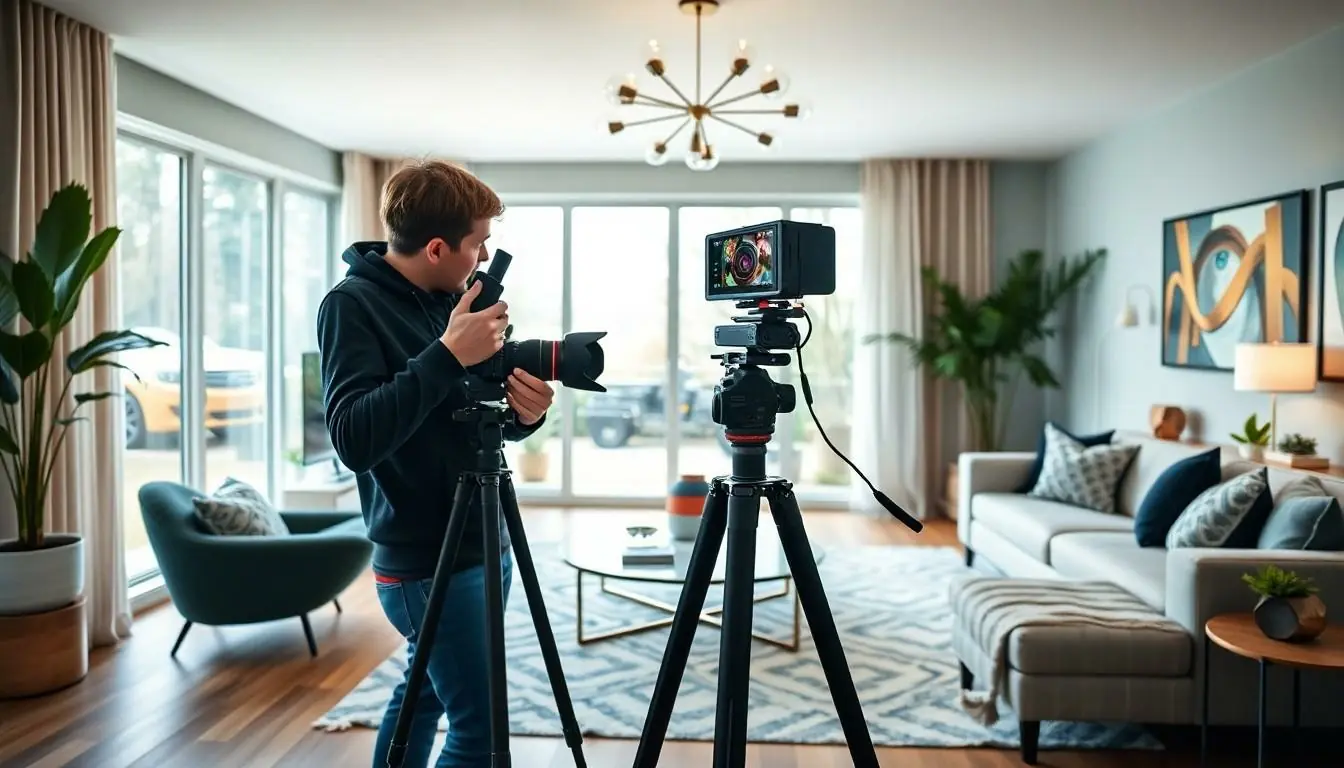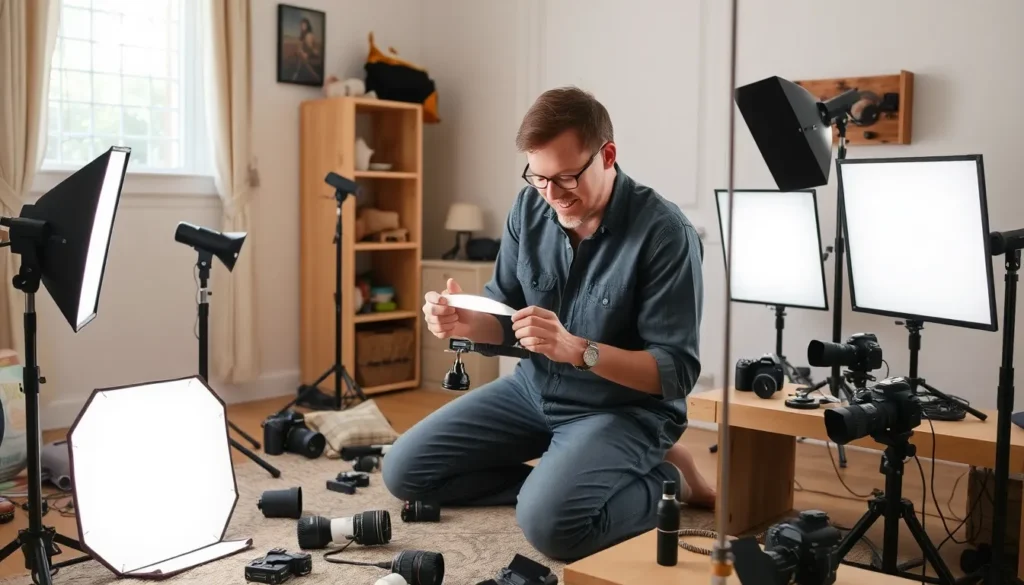Imagine stepping into a world where every click of your camera could lead to a lucrative career, all while showcasing stunning properties. Real estate photography isn’t just about snapping pictures; it’s about capturing the essence of homes and turning them into irresistible listings. If you’ve ever admired a beautifully staged room and thought, “I could make that look even better,” then you’re already on the right track.
Table of Contents
ToggleUnderstanding Real Estate Photography
Real estate photography entails capturing properties in a way that highlights their best features. Photographers in this field seek to create images that attract potential buyers.
Importance of High-Quality Images
High-quality images elevate property listings significantly. Buyers often make decisions based on visuals, as compelling photos draw attention. Professionals emphasize the need for proper lighting and composition. Crisp, well-lit photos convey a sense of space and ambiance. Listings with quality images receive more views, increasing the chances of a quick sale. Experts recommend using professional equipment to achieve the best results. A focus on details allows potential buyers to envision themselves in the space.
Common Styles in Real Estate Photography
Various styles exist in real estate photography to cater to different property types. Traditional photography focuses on wide-angle shots that showcase entire rooms. Aerial photography captures stunning views of properties from above, highlighting exterior features and the surrounding landscape. Twilight photography offers a unique perspective, featuring homes illuminated at dusk. Virtual tours have gained popularity, allowing viewers to explore spaces interactively. Each style serves specific purposes, helping to attract diverse audiences and meet various marketing needs.
Getting Started with Equipment

Investing in the right equipment is key for success in real estate photography. High-quality gear enhances image quality and simplifies the shooting process.
Essential Camera Gear
A DSLR or mirrorless camera is essential for real estate photography. Cameras with at least 20 megapixels provide ample resolution for large prints and online listings. Tripods stabilize images, ensuring crispness, especially in low-light conditions. Remote shutter releases eliminate camera shake and improve image clarity. Additionally, external flash units can enhance lighting in dimly lit areas, highlighting details that matter to potential buyers.
Recommended Lenses for Real Estate Photography
Wide-angle lenses play a crucial role in capturing expansive interior spaces. Lenses with a focal length of 16-35mm deliver stunning results by making rooms appear larger. Prime lenses with low f-stops provide excellent sharpness and depth of field. Tilt-shift lenses are also popular, allowing correction of perspective distortion common in architecture photography. Choosing the right lens helps portray properties effectively, attracting more viewings.
Developing Your Skills
Developing skills in real estate photography requires a solid understanding of key concepts and techniques. Mastering the basics sets the foundation for capturing stunning property images.
Photography Basics
Familiarity with camera settings enhances photo quality. Understanding elements like aperture, shutter speed, and ISO plays a vital role in achieving desired results. Wide-angle lenses are essential for capturing spacious interiors, allowing photographers to showcase properties effectively. Utilizing natural light creates brighter and more inviting images. Learning composition techniques, such as the rule of thirds, helps in framing shots beautifully. Regular practice improves proficiency, enabling photographers to adapt to varying conditions and styles.
Post-Processing Techniques
Post-processing significantly impacts the final image quality. Utilizing software like Adobe Lightroom or Photoshop enhances colors and sharpens details. Adjusting exposure, contrast, and saturation can transform ordinary images into captivating visuals. Effective cropping ensures that distractions are minimized while emphasizing key features. Moreover, merging multiple exposures can create high dynamic range (HDR) images, showcasing both highlights and shadows. Learning to use filters and effects judiciously adds creativity and appeal. Regularly refining these skills boosts the photographer’s portfolio and attracts more clients.
Building Your Portfolio
Building a strong portfolio is essential for any aspiring real estate photographer. A diverse range of projects can showcase skills and attract potential clients.
Types of Projects to Include
Including various types of projects enhances the portfolio. Begin with residential properties, since they form a significant portion of real estate photography. Commercial properties also add value, emphasizing versatility. Aerial photography projects demonstrate unique perspectives, captivating potential buyers. Twilight shoots can highlight properties in a striking way, emphasizing their ambiance. Virtual tours offer potential clients an interactive experience, showcasing photography skills and technology use.
Showcasing Your Work Online
Showcasing work online broadens visibility. A professional website serves as a central hub for sharing projects, allowing potential clients to view images and learn more about the photographer. Social media platforms like Instagram and Facebook can attract a broader audience and foster engagement with followers. Utilizing photography-specific sites, such as 500px or Shutterfly, helps reach niche audiences. Client testimonials can enhance credibility, influencing potential clients’ decisions. Regularly updating the online portfolio keeps content fresh and reflects growth in skills over time.
Networking and Finding Clients
Networking plays a vital role in establishing a successful real estate photography career. Building connections in the industry can lead to valuable opportunities and referrals.
Utilizing Social Media Platforms
Social media platforms offer effective ways to connect with potential clients and showcase work. Instagram serves as an ideal platform for sharing high-quality images, while Facebook groups focused on real estate provide chances to engage with agents and homeowners. Posting consistently keeps a photographer’s work fresh and visible. Engaging with comments and messages fosters relationships with followers. Sharing behind-the-scenes content gives insight into the creative process, further attracting interest. Setting up targeted ads can also reach specific demographics, enhancing visibility in local markets.
Collaborating with Real Estate Agents
Collaborating with real estate agents opens doors to consistent work opportunities. Agents often require professional photography to enhance property listings, making them an essential part of a photographer’s network. Attending industry events or local meetups helps in forming these relationships. Providing agents with a portfolio via email or targeted newsletters can spark interest in their services. Offering discounts or referral incentives encourages agents to utilize a photographer’s services and recommend them to clients. Open communication regarding preferences and project timelines ensures a productive partnership, ultimately benefiting both parties.
Real estate photography offers a rewarding career for those willing to invest time and effort into mastering their craft. With the right equipment skills and a strong portfolio photographers can effectively capture the essence of properties and attract potential buyers. Networking and building relationships within the real estate industry can open doors to new opportunities and consistent work. By staying updated on trends and continuously refining techniques photographers can elevate their work and stand out in a competitive market. Embracing these elements will pave the way for a successful journey in real estate photography.



